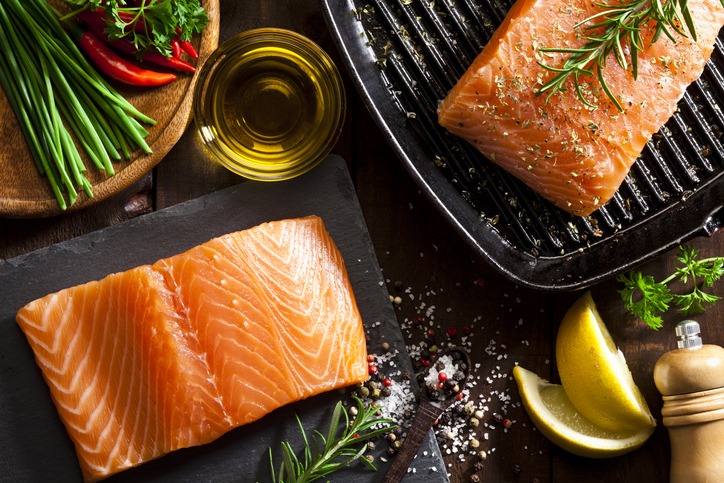Regarding salmon, there are two popular cuts that people often choose from – salmon steak and salmon fillet. Both are delicious and nutritious, but is one better than the other? Learn everything you need to know about the differences between salmon steak and fillet, including their nutritional value, health considerations, taste, and cooking methods.
What is Salmon Steak?
Salmon steak is a cross-sectional cut of the fish that includes the bone. This cut is typically taken from the middle or tail end of the fish and has a circular shape. The bone adds flavour and moisture to the fish, making it a popular choice for grilling.
What is Salmon Fillet?
Salmon fillet, on the other hand, is a boneless cut that is taken from the side of the fish. It is a long, thin cut that is easy to cook and versatile in recipes. Because it is boneless, it is often preferred by those who don’t want to deal with bones while eating.
Nutritional Differences Between Salmon Steak & Fillet
Both salmon steak and fillet are excellent sources of protein and healthy fats, including omega-3 fatty acids. However, there are some nutritional differences between the two cuts. Salmon steak contains more fat than fillet, which can provide additional flavour and moisture. However, this also means that it has a higher calorie count. Salmon fillet, on the other hand, is leaner and has a lower calorie count. It is a good choice for those who are watching their calorie intake but still want to enjoy the health benefits of salmon.
Health Considerations Regarding Salmon Steak & Fillet
When choosing between salmon steak and fillet, you should note some health considerations. Salmon steak contains bones, which can be a choking hazard for some people. However, the bones also contain calcium, which is important for bone health. Salmon fillet is a good choice for those concerned about mercury levels in fish. Because it is a boneless cut, it contains less mercury than salmon steak. However, both cuts are generally safe to eat in moderation.
Taste Differences Between Salmon Steak & Fillet
Salmon steak and fillet have different textures and flavours. Salmon steak is moist and tender, with a slightly stronger flavour than fillet. The bone adds a bit of richness to the taste, making it a popular choice for grilling or broiling. Salmon fillet is milder in flavour and has a firmer texture. It is a good choice for recipes with a more subtle salmon flavour, such as salads or pasta dishes.
Cooking Methods for Salmon Steak & Fillet
Both salmon steak and fillet can be cooked in a variety of ways, including grilling, baking, and pan-frying. However, some methods may be better suited for one cut than the other. Check out the various ways the two can be cooked to see the best method and meal for you to enjoy.
Salmon Steak vs Fillet: Which is Better for Grilling?
Salmon steak is a great choice for grilling because it is thick and moist, making it less likely to dry out over high heat. The bone also helps to insulate the flesh, allowing it to cook evenly. Fillet can also be grilled, but it may require more attention to prevent it from sticking to the grates.
Brush it with oil and season with your favourite spices to grill a salmon steak. Place it on a preheated grill and cook for about 4-5 minutes per side or until the flesh is opaque and flakes easily with a fork.
Salmon Steak vs Fillet: Which is Better for Baking?
Salmon fillet is a great choice for baking because it is thin and cooks quickly. It can be seasoned with herbs and spices or topped with a sauce or glaze for added flavour. Salmon steak can also be baked, but it may require a longer cooking time to ensure that the bone is fully cooked.
To bake salmon fillet:
- Preheat your oven to 425°F.
- Place the salmon on a baking sheet lined with parchment paper and season with salt and pepper.
- Bake for 12-15 minutes until the flesh is opaque and flakes easily with a fork.
Salmon Steak vs Fillet: Which is Better for Pan-Frying?
Salmon fillet is a great choice for pan-frying because it is thin and cooks quickly. It can be seasoned with herbs and spices or coated in breadcrumbs for added texture. Salmon steak can also be pan-fried, but it may require a longer cooking time to ensure the bone is fully cooked.
Heat a tablespoon of oil in a non-stick skillet over medium-high heat to pan-fry salmon fillet. Add the salmon and cook for 3-4 minutes per side, or until the flesh is opaque and flakes easily with a fork.
Ultimately, salmon steak and fillet are delicious and nutritious choices for seafood lovers. Salmon steak is a good choice for those who want a richer, more flavorful cut, while salmon fillet is a leaner option that is easier to cook and versatile in recipes. When choosing between the two cuts, consider your nutritional needs, health considerations, and cooking preferences. No matter which cut you choose, salmon is a tasty and healthy addition to any meal.

